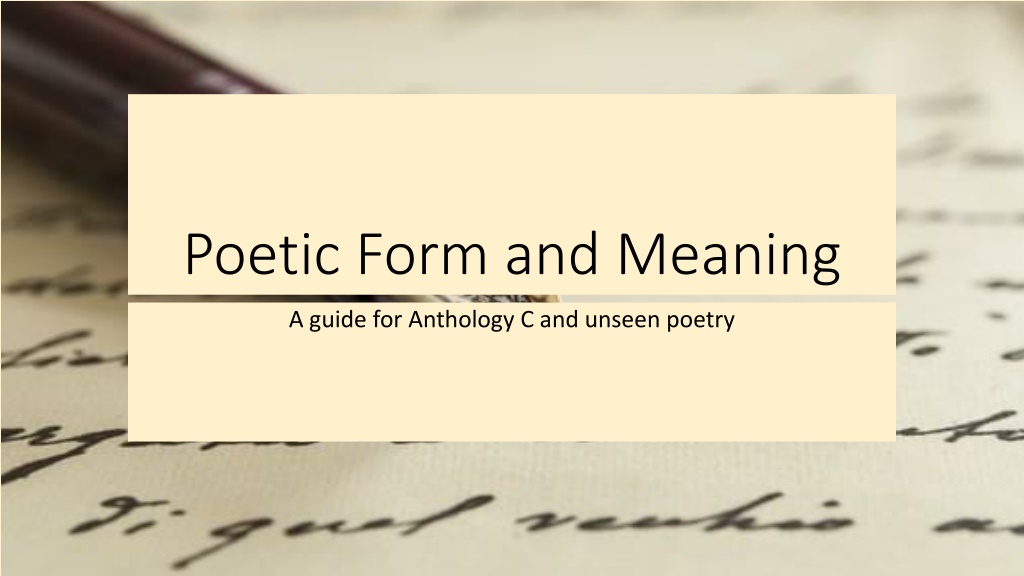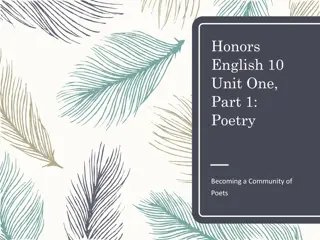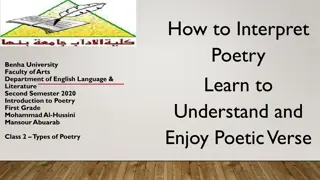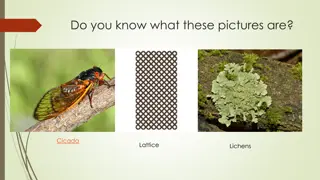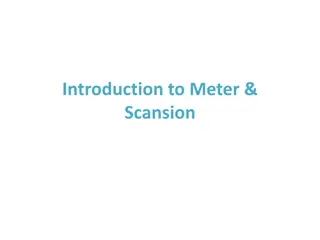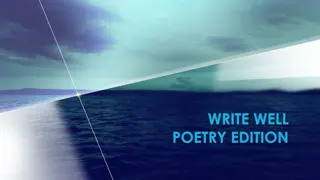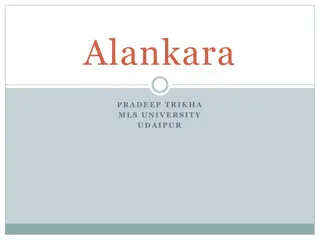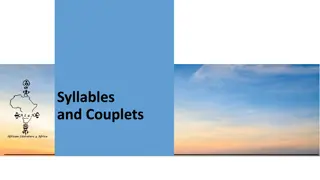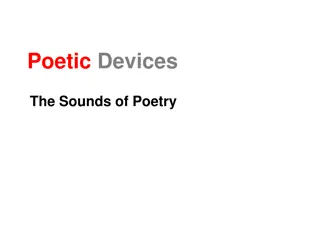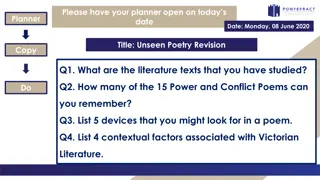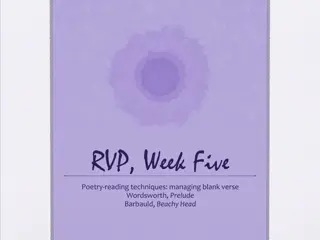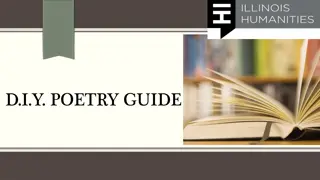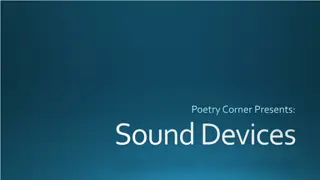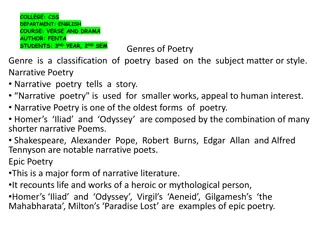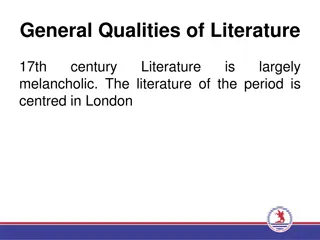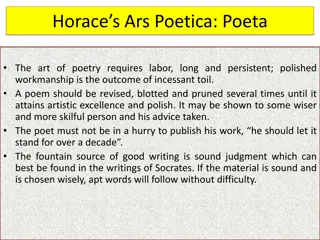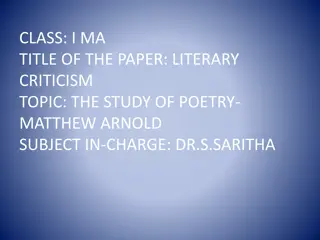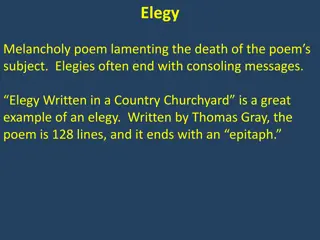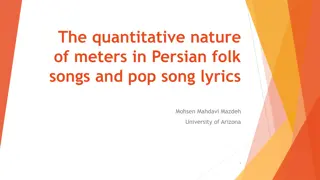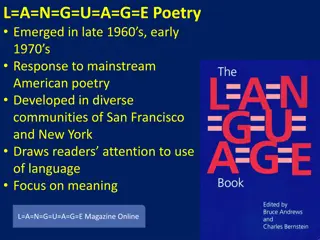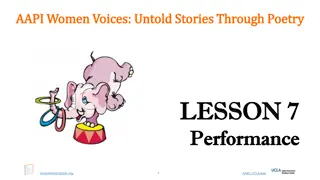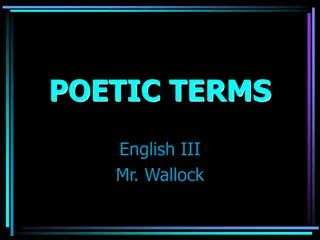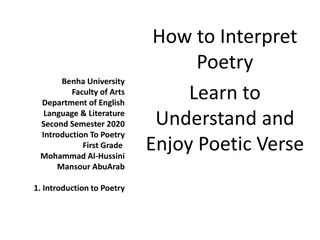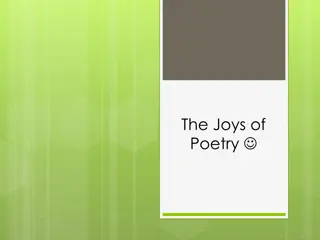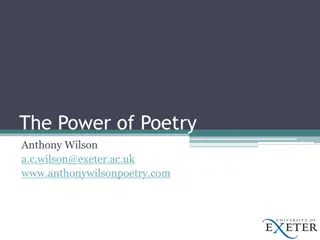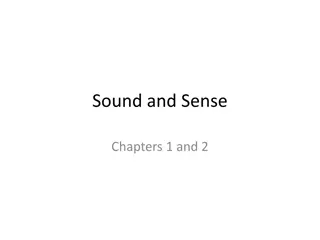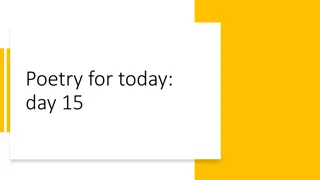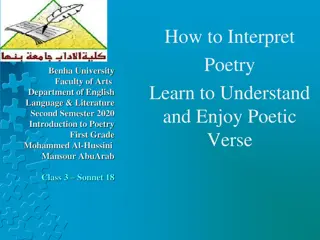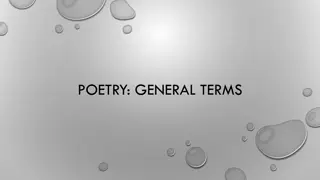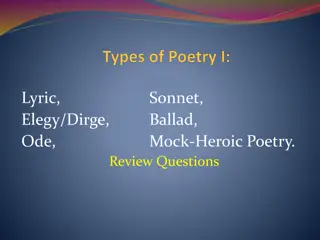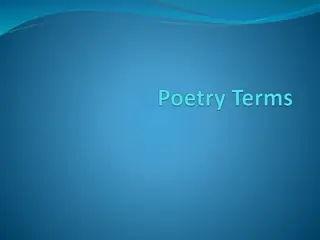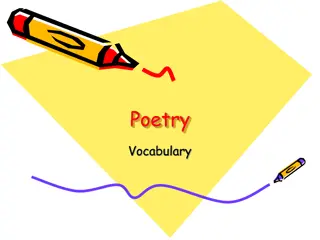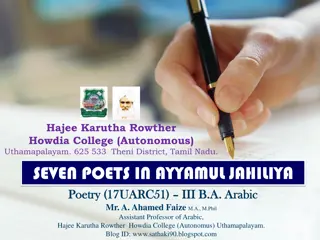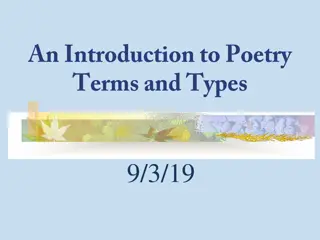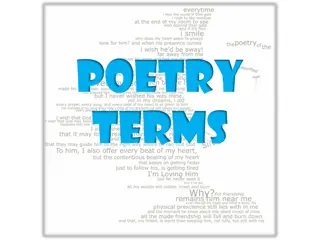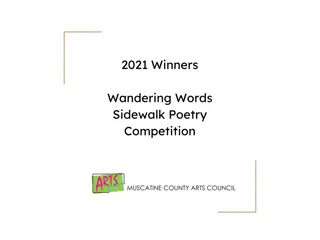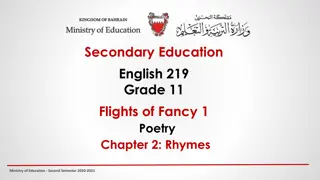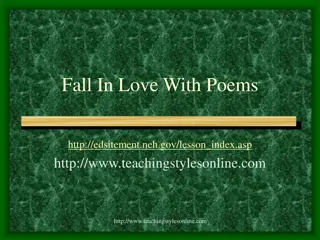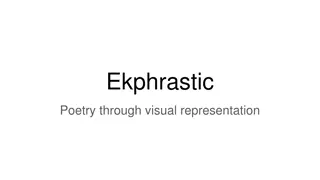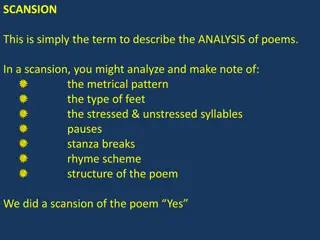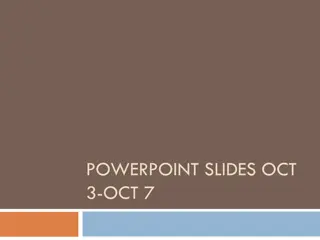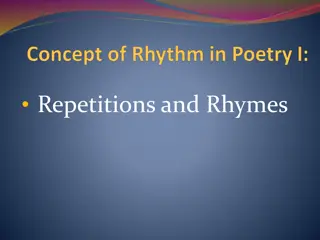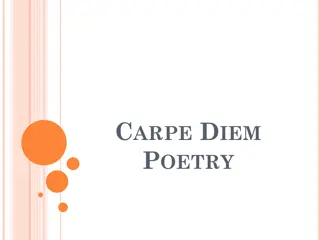Understanding Poetic Form and Meaning in English Poetry
Explore the intricate elements of poetic form, such as rhyme, meter, stanzas, and refrains, in popular English forms like ballads, sonnets, odes, and free verse. Delve into the significance of traditional ballads like "La Belle Dame sans Merci" and "The Tyger," discovering how these poems subvert expectations while utilizing rhyme and diction effectively to convey complex emotions and ideas. Further reading recommendations include works by William Blake, Langston Hughes, and Emily Dickinson that showcase the diverse uses of ballad form in expressing social, philosophical, and emotional themes.
Uploaded on Sep 23, 2024 | 0 Views
Download Presentation

Please find below an Image/Link to download the presentation.
The content on the website is provided AS IS for your information and personal use only. It may not be sold, licensed, or shared on other websites without obtaining consent from the author. Download presentation by click this link. If you encounter any issues during the download, it is possible that the publisher has removed the file from their server.
E N D
Presentation Transcript
Poetic Form and Meaning A guide for Anthology C and unseen poetry
Features of form: Features of form: Rhyme Metre Stanzas Refrains Title
Some popular forms in English: Some popular forms in English: Ballad / song / hymn Sonnet Ode Free verse Villanelle Forms using iambic pentameter Elegy
Ballads Ballads Regular rhyme scheme e.g. abab, abcb Usually quatrains (but not always) Trimeter and tetrameter associated with ballad metre Simple diction Narrative (tell a story) rather than lyric (focus on emotions) Objective (3rd-person narrators) rather than subjective May contain dialogue and archetypal figures One of the oldest poetic forms in the English language
La Belle Dame sans Merci and The Tyger La Belle Dame sans Merci and The Tyger Both have a regular rhyme scheme and are in quatrains Both have ballad metre Both use simple diction HOWEVER: both are subjective and lyric
Ballad and meaning Ballad and meaning Both the ballads in the anthology are subversive They might purport to tell a story but focus instead on emotions and abstract ideas Blake uses it ironically to convey the simplicity and innocence of a child s sense of wonder (the poem originally came from his Songs of Innocence and Experience) at something incomprehensible Keats uses the form ironically to present the complexity of the conventional medieval romance tale However, their use of the form is significant and conventional in one way: Rhyme and simple diction make both poems memorable
Further reading Further reading William Blake, Songs of Innocence and Songs of Experience Lyrical Ballads (Wordsworth and Coleridge) groundbreaking ballads with simple diction and complex philosophical and social ideas Langston Hughes, various ballads very simple language to express anger at political and social injustice in C20th Emily Dickinson s ballads for ironic use of simple diction and metre to convey sceptical or abstract ideas
Sonnet Sonnet 14 lines long Usually has a regular rhyme scheme Usually written in iambic pentameter Emerged from print culture during the Renaissance Has associations with courtly virtues, love, praise etc. Usually consists of an octet and a sestet Volta is the turning point The rhyming couplet is often a resolution or affirmation
Sonnet and meaning Sonnet and meaning A Petrarchan sonnet, Rossetti s poem follows formal conventions of length, metre, and rhyme Shakespeare s sonnets deviate from the Petrarchan model (rhyming couplet, rhyme scheme) but retain the conventional subject matter of love Both poets use the form to transcend conventional love poetry Rossetti: sonnets became integral to Romantic poetry and linked poets with giants such as Shakespeare, Milton, Spenser, and, later, Wordsworth the use of the form therefore also elevates the poet Shakespeare uses the intricacy of the form to demonstrate the superiority of the sonneteer Rossetti uses it to subvert idealistic love/romance and foreground the individual within the relationship
Further reading Further reading Shakespeare s various sonnets praise, love, time, immortality Romantic sonnets e.g. Keats, Wordsworth, Coleridge
Ode Ode The ultimate classical lyric form Conventionally used by Greek poets to glorify what they saw as important people or topics Enjoyed a major resurgence during the Romantic period Variations: Pindaric, Horation, and irregular Pindaric: strophe, antistrophe, and epode Horation: one stanza form repeated Irregular: no formal pattern
Ode and meaning Ode and meaning Odes are usually written on a famous person, event or a virtue Many Romantic, modern, and contemporary poets subvert this by focusing on subjective experience However, most are conventional in their attempt to immortalise their subjects
Further reading: famous Romantic odes Further reading: famous Romantic odes John Keats, Ode to a Nightingale , Ode to Psyche , Ode on a Grecian Urn , Ode to Melancholy , To Autumn P. B. Shelley, Ode to the West Wind William Wordsworth, Immortality Ode S. T. Coleridge, Dejection: an Ode
Free verse Free verse No set formal patterns i.e. rhyme scheme, metre, line/stanza length May or may not contain rhyme frequently uses internal or half-rhyme However, it is carefully structured As old as the Bible but became increasingly popular with Modernism; it is therefore seen as a fairly new form (since the early C20th) Free verse is often consciously political; by freeing verse from poetic constraints, poets are making a statement about being politically, socially, or emotionally free
Free verse and meaning Free verse and meaning Almost all the free verse poems in the Anthology use free verse to explore feelings of displacement, confusion, or isolation Short/abrupt lines may reflect a fragmented sense of being The use of form reflects a negative aspect of freedom i.e. to the point where one does not belong to a specific place or time Free verse is one of the most popular forms for contemporary poetry e.g. your unseen Free verse rarely praises or elevates topics; instead it typically magnifies subjective experience The irregularity of it often reflects the uncertainties of modern life
Iambic pentameter Iambic pentameter Typical forms involve blank verse, heroic couplets, and dramatic monologue Five metrical feet per line with an unstressed/stressed syllable pattern (ti-tum-ti-tum-ti-tum-ti-tum-ti-tum) Seen to mirror conversation and natural speech Emerged at the end of the medieval period print culture Some of the greatest works in literature use this metre
Pentameter and meaning Pentameter and meaning Heroic couplets usually used for satire and witty poems Because it is seen to mirror speech, it is conversational and often subjective or personal e.g. Hide and Seek , If As the metre favoured by Shakespeare, it can reflect aspects of drama e.g. My Last Duchess with its dramatic monologue form clearly presents a character
Further reading Further reading Robert Browning frequently uses this metre/form to tell a story Sophie Hannah, Postcard From a Travel Snob as with My Last Duchess , it uses the form to show how deluded the speaker is Wordsworth, The Prelude the first autobiographical poem Coleridge, conversation poems use the metre to form an intimate tone Chaucer, The Canterbury Tales drama and narrative Any Shakespeare play! Carol Ann Duffy famous contemporary poet who frequently uses the metre
Elegy Elegy Can follow any formal pattern but is characterised by its focus on death Elegies are usually written as a memorial to a person or group of people However, a poem can bean elegy for a place or time period that is no longer the way it was Some poems might not be, strictly speaking, elegies but may have an elegiac tone
Further reading Further reading Thomas Gray, Elegy Written in a Country Churchyard classic elegy and inspiration for Romantics and Moderns Wordsworth s Lucy poems elegiac ballads for an unknown subject Tennyson, In Memoriam John Milton, Lycidas W. H. Auden, Funeral Blues
Villanelle Villanelle French poetic form adapted from a medieval Italian folk form about rural life (oral form, so designed to be memorable) Five tercets and a quatrain (ABA ABA ABA ABA ABA ABAA) Has a clear rhyme scheme and is repetitive Features refrain of two lines and so is ideal for emphasising an argument powerfully
Further reading Further reading Elizabeth Bishop, One Art a famous modern villanelle containing black humour Sylvia Plath, Mad Girl s Love Song Theodore Roethke, The Waking
